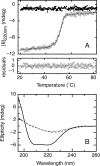Folding of a cyclin box: linking multitarget binding to marginal stability, oligomerization, and aggregation of the retinoblastoma tumor suppressor AB pocket domain
- PMID: 23632018
- PMCID: PMC3696668
- DOI: 10.1074/jbc.M113.467316
Folding of a cyclin box: linking multitarget binding to marginal stability, oligomerization, and aggregation of the retinoblastoma tumor suppressor AB pocket domain
Abstract
The retinoblastoma tumor suppressor (Rb) controls the proliferation, differentiation, and survival of cells in most eukaryotes with a role in the fate of stem cells. Its inactivation by mutation or oncogenic viruses is required for cellular transformation and eventually carcinogenesis. The high conservation of the Rb cyclin fold prompted us to investigate the link between conformational stability and ligand binding properties of the RbAB pocket domain. RbAB unfolding presents a three-state transition involving cooperative secondary and tertiary structure changes and a partially folded intermediate that can oligomerize. The first transition corresponds to unfolding of the metastable B subdomain containing the binding site for the LXCXE motif present in cellular and viral targets, and the second transition corresponds to the stable A subdomain. The low thermodynamic stability of RbAB translates into a propensity to rapidly oligomerize and aggregate at 37 °C (T50 = 28 min) that is suppressed by human papillomavirus E7 and E2F peptide ligands, suggesting that Rb is likely stabilized in vivo through binding to target proteins. We propose that marginal stability and associated oligomerization may be conserved for function as a "hub" protein, allowing the formation of multiprotein complexes, which could constitute a robust mechanism to retain its cell cycle regulatory role throughout evolution. Decreased stability and oligomerization are shared with the p53 tumor suppressor, suggesting a link between folding and function in these two essential cell regulators that are inactivated in most cancers and operate within multitarget signaling pathways.
Keywords: Cyclin Fold; Marginal Stability; Oligomerization; Protein Aggregation; Protein Folding; Protein Misfolding; Protein Stability; Retinoblastoma (Rb); Scaffold Proteins; Tumor Suppressor.
Figures













Similar articles
-
Structure of the retinoblastoma tumour-suppressor pocket domain bound to a peptide from HPV E7.Nature. 1998 Feb 26;391(6670):859-65. doi: 10.1038/36038. Nature. 1998. PMID: 9495340
-
Mutagenesis of the pRB pocket reveals that cell cycle arrest functions are separable from binding to viral oncoproteins.Mol Cell Biol. 2000 May;20(10):3715-27. doi: 10.1128/MCB.20.10.3715-3727.2000. Mol Cell Biol. 2000. PMID: 10779361 Free PMC article.
-
Destabilization of the retinoblastoma tumor suppressor by human papillomavirus type 16 E7 is not sufficient to overcome cell cycle arrest in human keratinocytes.J Virol. 2001 Aug;75(15):6737-47. doi: 10.1128/JVI.75.15.6737-6747.2001. J Virol. 2001. PMID: 11435552 Free PMC article.
-
Interactions of SV40 large T antigen and other viral proteins with retinoblastoma tumour suppressor.Rev Med Virol. 2002 Mar-Apr;12(2):81-92. doi: 10.1002/rmv.340. Rev Med Virol. 2002. PMID: 11921304 Review.
-
[Molecular mechanisms controlling the cell cycle: fundamental aspects and implications for oncology].Cancer Radiother. 2001 Apr;5(2):109-29. doi: 10.1016/s1278-3218(01)00087-7. Cancer Radiother. 2001. PMID: 11355576 Review. French.
Cited by
-
p53 reactivation with induction of massive apoptosis-1 (PRIMA-1) inhibits amyloid aggregation of mutant p53 in cancer cells.J Biol Chem. 2019 Mar 8;294(10):3670-3682. doi: 10.1074/jbc.RA118.004671. Epub 2019 Jan 2. J Biol Chem. 2019. PMID: 30602570 Free PMC article.
-
p53 amyloid aggregation in cancer: function, mechanism, and therapy.Exp Hematol Oncol. 2022 Sep 28;11(1):66. doi: 10.1186/s40164-022-00317-7. Exp Hematol Oncol. 2022. PMID: 36171607 Free PMC article. Review.
-
The aggregation of mutant p53 produces prion-like properties in cancer.Prion. 2014 Jan-Feb;8(1):75-84. doi: 10.4161/pri.27776. Prion. 2014. PMID: 24509441 Free PMC article.
-
Conformational buffering underlies functional selection in intrinsically disordered protein regions.Nat Struct Mol Biol. 2022 Aug;29(8):781-790. doi: 10.1038/s41594-022-00811-w. Epub 2022 Aug 10. Nat Struct Mol Biol. 2022. PMID: 35948766 Free PMC article.
-
Chaperone-tip adhesin complex is vital for synergistic activation of CFA/I fimbriae biogenesis.PLoS Pathog. 2020 Oct 2;16(10):e1008848. doi: 10.1371/journal.ppat.1008848. eCollection 2020 Oct. PLoS Pathog. 2020. PMID: 33007034 Free PMC article.
References
-
- van den Heuvel S., Dyson N. J. (2008) Conserved functions of the pRB and E2F families. Nat. Rev. Mol. Cell Biol. 9, 713–724 - PubMed
-
- Khidr L., Chen P. L. (2006) RB, the conductor that orchestrates life, death and differentiation. Oncogene 25, 5210–5219 - PubMed
-
- Macaluso M., Montanari M., Giordano A. (2006) Rb family proteins as modulators of gene expression and new aspects regarding the interaction with chromatin remodeling enzymes. Oncogene 25, 5263–5267 - PubMed
Publication types
MeSH terms
Substances
LinkOut - more resources
Full Text Sources
Other Literature Sources
Research Materials
Miscellaneous

